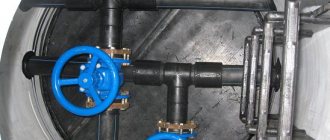Purchasing lawn with delivery is an excellent alternative to long and painstaking cultivation.
But an expensive purchase will take root in a new place only if it is installed correctly. This article will tell you how to lay a rolled lawn.
Calculation of the number of rolls
The number of rolls required to cover the area is determined as follows:
- calculate the area of the site by multiplying its width and length: S = A * B;
- divide the area of the section S by the area of one roll. The most common format of rolled lawn is 2x0.4 m, respectively, the area of the roll is 0.8 m. In this case, to cover an area of 100 square meters. m will need 100/0.8 = 125 rolls.
There are also rolls with an area of 0.6 square meters. m (dimensions 2x0.3 m).
With this format, to cover an area of 100 squares, you will need 100/0.6 = 167 rolls. Manufacturers' websites often suggest multiplying the area of the plot by a certain coefficient. The essence is the same, just the multiplier 1/0.8 or 1/0.6 is replaced by this same coefficient. In the first case it will be 1.25, in the second - 1.67. Multiplying 100 sq. m by these coefficients, we get the same 125 and 167 rolls.
A margin is added to the resulting number:
- in the absence of landscape objects on the site: 5%;
- if there are paths, flower beds or fountains: 10% (more waste).
Thus, for a lawn of 100 square meters. m with a complex landscape design (10% margin), with a roll area of 0.8 sq. m will require 100 * 1.25 * 1.1 = 137.5 rolls (if necessary, add a margin of 5% instead of the coefficient 1.1, use 1.05).
Having calculated the required number of rolls, place an order, while adhering to the following rules:
- The purchase and delivery are planned so that the lawn is laid within 24 hours. That is, the site should be prepared in advance. If laying work is delayed for more than a day, the lawn cannot be left in rolls: it is rolled out and watered;
- the later the covering is laid, the worse the grass takes root;
- it is important to lay the entire area at once in one approach - then the coating will be even and uniform over the entire area;
- a place in the shade is allocated for unloading rolls;
- in hot, dry weather, the rolls are sprayed with water.
The optimal time to plant a lawn is spring or autumn, when the sun is not shining and the soil is rich in moisture.
It is useful for a potential buyer to know the signs of a high-quality rolled lawn (one roll is rolled out to check):
- layers of turf and grass are of equal thickness along the entire perimeter;
- no weeds;
- the grass grows in an even layer without bald spots;
- the roots are tightly intertwined. Significant gaps between them indicate low quality.
When you try to pull the cloth towards you, the grass does not lag behind the main layer. Otherwise, the plants will not take root well.
Photo
Signs of quality turf
Compacting the soil
Rolled lawn is supplied as follows:
Spreading and compacting the lawn
Laying lawn roll
Roll trimming
Landscape gardening
Did the article help you?
Preparing the area
The site is prepared for laying rolled lawn in the following order:
- remove debris and foreign objects;
- uproot old tree roots and stumps;
- remove weeds in one of two ways: by hand weeding or by treating with a continuous herbicide, such as Roundup. The herbicide is effective for 2–3 weeks and is applied to the green mass. If you decide to get rid of weeds manually, it is recommended to dig up the area, removing the roots. Of these, the most tenacious plants, such as wheatgrass and dandelion, will grow through the lawn and then be difficult to remove. Along the way, the area gets rid of insect pest larvae;
- If necessary, arrange drainage. It is required if there are puddles of water on the site after a rainstorm or during snow melting. This happens on clay soils located in lowlands;
- if there is no need for drainage, the soil is loosened to a depth of 5–10 cm. In small areas this is done with a hand aerator or forks, in large areas with a walk-behind tractor.
Drainage is done like this:
- cut off the top layer of soil 40 cm thick and put it aside (will be needed later);
- First, a layer of gravel 10 cm thick is poured into the excavation and compacted, then a layer of sand of the same thickness (replacing sand with geotextiles is allowed);
- On top of the gravel-sand cushion, the previously removed fertile soil is poured to ground level.
If the soil on the site is poor in humus, it is cut off and replaced with fertile soil. The latter should have a thickness of at least 10–15 cm.
Features of preparatory work
The soil is excavated to a depth of 15-20 cm. When reusing the soil, it must be sifted, weeds and roots removed, and fertilizer applied. It is possible to use soil from a nursery. The cost of such a prepared base will be about 1000 rubles. per cubic meter m. At this stage, horizontal planning of the base is carried out.
The more thoroughly the base is cleaned, the easier it will be to install the lawn, the more durable the coating will be, and the less likely it is to grow weeds. Here you can apply treatment with chemical plant protection products.
Poor compaction of the base can lead to subsidence and unevenness in the future.
When marking, the most important thing is to align the first pilot layer evenly and correctly. Subsequent ones are laid close to the first. Smooth laying is done using pegs and a stretched cord.
Creating a Horizontal Surface
During the preparation process, the area is leveled. A convenient guide is several pieces of string stretched between pegs. The distance from them to the ground shows where soil needs to be added and where it needs to be cut.
Leveling the area with a garden roller
If drainage is not installed on the site, the surface is planned with a slope of 60 in order to drain rain and melt water.
Soil rolling
The next step is soil compaction. Without this, it will sag over time (there are always cavities in the top layer) and unevenness will appear on the lawn. Compaction is done with a garden roller (filled with water), and if there is none, with a log or wide board.
Normally, compacted soil should not sag under the feet of an adult. The area should be planned and rolled so that ultimately its surface is 2-2.5 cm lower than the path (the thickness of the turf in a roll).
The area is watered and fertilized:
- in spring or summer: nitrogenous fertilizers;
- autumn: phosphorus-potassium.
There are complex fertilizers for lawns on sale, which include, in addition to the main elements mentioned, a number of additional ones that promote the rapid establishment and full development of grass.
After pouring the fertilizer, you should walk around the area with a rake to distribute it evenly and lightly mix it with the soil.
Material selection
There are two types of materials from which you will have to choose if you want to create a green lawn. These include: geofabric and geotextile. The most suitable option is the second one, since it is capable of passing water, thereby nourishing and moistening the soil for the lawn. To plant grass, you need to choose a canvas with a density of 100 g/m². Lawn grass is purchased at the discretion of the owner, but the number of seeds per 1 m² must be at least 60 g.
The material should be laid so that each subsequent canvas overlaps the previous one, which means that when purchasing it is necessary to increase the amount of purchased geotextile.
Laying out the turf
The lawn is laid in this order:
- string is pulled along the perimeter of the site in order to mark its boundaries
- in the corner on the side of the unloading area, roll out the first roll and adjust it, giving it the correct position. The rolled lawn is quite durable - you can safely drag it by hand;
- Roll out the second along the long side of the first roll so that their edges touch. Overlapping (overlapping one edge over another) is not allowed, as is a significant gap - no more than 1.5 cm;
- Cut half of the second roll using a garden knife or bayonet shovel. This is done to ensure that the seams in the rows do not match. This approach is reminiscent of laying bricks with staggered joints;
- apply the third and fourth rolls to the narrow sides of the first and second rolls, roll them out and straighten them.
Rolls are rolled out only in a straight line. If you try to bend them, folds and tears will appear on the lawn, and then bald spots (due to poor grass survival in these places). If the covering covers, for example, the corner of a flower bed, it is rolled out and then the excess is cut off.
Similarly, lay the entire area with lawn, ensuring the spacing of the seams by cutting the first rolls in half in even rows. The cut piece is placed at the end of the row.
Laying lawn rolls
The grass takes root worst of all at the edge of the site, so it is important to lay fragments at least 1 m long here. Smaller trimmings are left for the middle part.
If the site has a significant slope, the rolls are rolled out across the slope (horizontally) and reinforced with pegs.
Advantages and disadvantages
Let's start with the positive characteristics.
- There is no need to prepare the soil, sow grass and care for young greenery.
- The finished green coating easily tolerates low frosts , drought and is immune to various diseases.
- Does not allow weeds .
- Easy to care for.
- Long-term operation .
And the characteristics are negative.
- High price . Rolled lawn with installation costs on average 400-700 rubles per 1 m2. The price range depends on the planted area. The higher the last indicator, the lower the price.
- A large number of low-quality products on the modern market. You can purchase material that simply will not take root or will last one season.
- The service life is an order of magnitude lower than that of a seeded lawn.
Formation compaction
Having finished the next row, the lawn is pressed down with a roller or a wide board, this gives a double effect:
- a tight fit of the turf to the base is ensured;
- the panels are fused at the seams.
If the coating is dry, it is moistened before rolling. At the same time, it is stroked with the palm of your hand to identify depressions and tubercles. If any are found, lift the panel and level the base by adding or removing soil.
The lawn is then pressed down again. If laying the next row requires standing on a freshly laid surface, lay a wide board or wooden flooring. Otherwise, the turf will squash.
Watering
After laying, the lawn is filled with water. Water supply by stream is not allowed - only by a sprinkler or nozzle.
The intensity of watering should be such that the soil base under the panels is saturated with moisture to a depth of 2-3 cm. This is checked by raising the edge of the lawn at 10-12 points along the entire perimeter.
The lawn is watered when the sun is low - in the morning or evening. Water droplets focus the sun's rays like a lens, which is why the grass suffers from burns during daytime watering. During the first 7-14 days (depending on the weather), the lawn is watered daily at the rate of 10-15 l/m2.
Whether watering is sufficient is checked according to the following criterion: the soil base under the lawn turf should be moist to a depth of 5 cm. To check this, it is allowed to raise the edge of the covering in several places during the first week.
Automatic watering systems are very convenient. The user programs the control unit, setting the on/off schedule and other parameters, after which the system operates without his participation.
Roll lawn care
The user is advised to adhere to the following instructions:
- During the first 30 days after installation, walking on the lawn is prohibited. If it is necessary to do this, place a boardwalk under your feet, and after use it is immediately removed;
- The optimal frequency of watering is once every 5 days. In hot weather - more often; in rainy weather, watering is canceled altogether;
- cut the grass when it reaches a height of 4–6 cm, but not earlier than the 8th day after laying. Most often this has to be done for the first time after 2–4 weeks.
During the first mowing, the lawn mower is moved across the rolled rolls. In late autumn, shortly before the arrival of cold weather, the lawn is cut to a height of 5 cm. This grass will overwinter well under the snow. It is advisable to remove cut grass so that it does not block access to air, sun and water into the soil.
There are three ways to remove cut grass:
- use a lawn mower with a grass catcher;
- remove debris manually with a rake;
- periodically treat the lawn with a special tool - a scarifier: it cuts the accumulated “felt” from the cut grass with knives and collects it in a bag.
In addition to watering and mowing, the following activities are carried out:
- fertilization;
- mulching: leaving small amounts of cut grass as fertilizer and to prevent soil loss of moisture;
- aeration;
- removing weeds.
Main stages of preparatory work
Before laying the lawn, the following work must be done:
- cutting the soil to a certain level (the level of the curb or paving slabs);
- removal of weeds and debris;
- compaction of the base (usually done with a hand roller);
- installation of a drainage system made of sand, screenings or small crushed stone with compaction;
- backfilling the drainage with previously removed soil or special lawn soil and compaction;
- surface marking.











